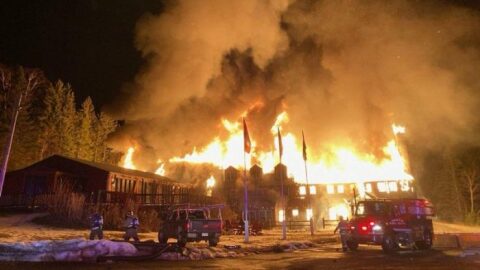COHASSET — Two days after an estimated 1 million gallons of coal ash wastewater spilled at Minnesota Power’s Boswell Energy Center in Cohasset, there are still many unknowns.
The leak likely began from an underground pipe and surfaced where the pipe extends above the ground, according to the Minnesota Pollution Control Agency. Minnesota Power said the pipe transfers coal ash wastewater from an inactive pond to the plant for process water.
The wastewater was released into the soil and flowed to Black Water Creek and into Blackwater Lake, an impoundment of the Mississippi River and part of the Pokegama Reservoir system.
Bay West, Minnesota Power’s environmental contractor, set up deep-skirted booms and staked a silt curtain to the lakebed on Blackwater Lake on Thursday, July 18.
Bay West Site Supervisor Taylor Vichorek didn’t observe any glaring issues on the lake Wednesday.
“Went up there [Blackwater Lake] and tested right on the edge of the wild rice and everything the whole way, all the way up and back, looked good,” he said in an interview at the Blackwater Lake boat launch.

Vichorek said Minnesota Power estimates around half of the one million gallons of wastewater escaped containment, though it’s unclear how much, if any, entered the lake.
“We’re thinking that the vegetation and stuff around where the leak point was, if there is anything, it’s keeping it all right there,” he said.
In addition to setting up barriers, Bay West planned to test water for contaminants and conduct flow testing for more information on how a leak could spread.
The spill did not affect sewers, the MPCA said. The agency and the Minnesota Department of Health are also evaluating downstream receptors and drinking water intakes, though Minnesota Power believes no drinking water was affected, spokesperson Amy Rutledge said in a Wednesday email to KAXE.
Units 1 and 2 of Boswell Energy Center, Minnesota Power’s largest plant, were retired in 2018, leaving two units running. Vichorek said Minnesota Power staff told him that as a result, the wastewater did not contain as much ash as it has historically and is relatively clean compared to what it was before.
In an updated statement Thursday, MPCA said its staff are working with Minnesota Power, the U.S. Environmental Protection Agency and environmental contractors to assess the situation, get sampling and monitoring plans in place and minimize impacts to the creek and lake.

“The sampling and monitoring plan will help determine how widespread or severe the impacts are, and what tools and technology will be most effective to minimize impacts,” the statement read.
Leech Lake Emergency Management Director Duane Oothoudt drove to the Blackwater Lake boat launch Thursday to try to learn more about the situation.
“We’re a little bit concerned, people rice here, and they eat the rice,” he said. “We come up and we harvest it every year. Me and the chief of police, actually, we rice here together from Leech Lake.
We just want to know cause this impacts a lot of the local harvesters and foragers and our land rights. It’s pretty close to the reservation border, so it does impact us. So, we’re concerned, we just want to know what’s going on.”
Oothoudt said he was concerned about potential heavy metal contaminants and how the leak would impact the quality of the rice.
“This is where the food grows on water. That’s why we’re here,” he said. “This is in ceded territory. We retained our harvesting rights; we didn’t give those up. And so, we still have a little bit of say in how things are taken care of.”
He also has questions about why contaminants were present in the first place.
“I’m told that it was a million gallons, and that’s a lot of water that’s contaminated, and why is it being impounded in the first place and what’s in it?” Ooothoudt said. “ ... Me as an emergency manager, I look at it and say, ‘Well, what kind of mitigation can be done to prevent this in the future?’”
Funding for this environmental story was provided by the Minnesota Environment and Natural Resources Trust Fund as recommended by the Legislative-Citizen Commission on Minnesota Resources (LCCMR).
-
Child care providers, local officials and families discussed the high costs of child care and the low wages of child care workers during the Bemidji Affordability Forum on Dec. 3, 2025.
-
The North Central Research and Outreach Center helped test our state fruit for winter hardiness, a step in its eventual release as the University of Minnesota's first apple variety.
-
Financial records showed Bryce James Campbell’s companies near-due and past-due business debts amounted to more than $14 million when the fire destroyed the beloved North Shore resort.
-
Minnesota's program distributes funding to more than 100,000 income-eligible households. About 40% had a person over age 60 or with a disability, and 1 in 6 had children younger than 6.









